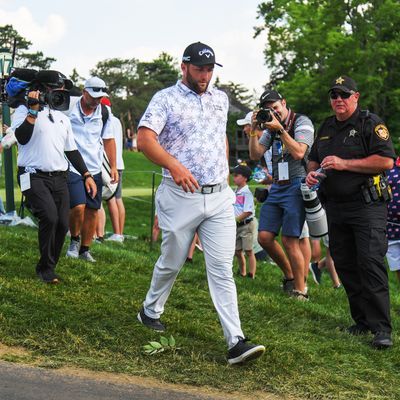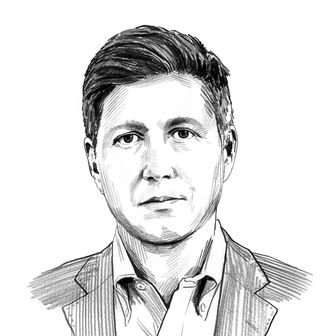
Golf is designed for masochists; it’s a sport that exists to make you feel bad about yourself. Even for professionals, it’s an exceedingly rare day when everything on the course is going perfectly, and on the rare days it happens, you want to soak it up.
Jon Rahm, a 26-year-old Spaniard who until very recently was the top-rated golfer in the world, was having one of those days this past weekend. At the Memorial Tournament in Ohio, Rahm hit a hole in one on Saturday and spent most of the rest of the day laying waste to his competitors, taking a six-stroke lead heading into Sunday’s final round. He was 24 hours of not-blowing-a-big-lead away from earning a $1.674 million payday and considerable momentum toward his first golf Major, with the U.S. Open just two weeks away. Things were going great!
Then he tested positive for COVID-19. They literally told him right there on the course. It’s quite something to watch:
And that … was it. He was bonked out the tournament right then and there. No championship, no best round ever, no $1.674 million. Rahm has been asymptomatic and is isolating for the next week: With any luck, he’ll be back for the U.S. Open. But he’ll never get that perfect day back.
Rahm’s positive test — again, one he was informed of right there on the course — seems to mark a new phase of COVID-19 in the world of sports. We have spent the last year seeing a COVID-19 positive test as a debilitating occurrence for athletes, not just for their personal health but for the ability of leagues to move forward. The college football season was almost entirely canceled because of COVID, MLB commissioner Rob Manfred threatened to shut down the season on baseball’s very first weekend last year, and Duke men’s basketball coach Mike Krzyzewski wondered, after a loss last year, whether any of his sport’s games should be happening at all. The lasting image of the last World Series was not of celebratory Dodgers players, but star third baseman Justin Turner — who had tested positive and had to be pulled from the final game — running out, maskless, to celebrate and pose for pictures with his teammates.
But the collective reaction to Rahm’s positive diagnosis was something different. It was closer to being along the lines of man, what an idiot. And that’s because Jon Rahm was not vaccinated.
This has not been announced officially. (Rahm studiously avoided mention of his vaccination status in his statement on Saturday.) But the only people the PGA is testing anymore are non-vaccinated players, so it’s pretty easy to draw conclusions. Rahm had initially been subject to contact tracing after having been exposed to someone who tested positive, and he’d spent the last week getting regularly tested and avoiding “indoor club facilities.” It is his misfortune that his positive test came just as he was about to win a golf tournament. But it is his misfortune by choice, because he chose not to be vaccinated. He now has 1.674 million reasons that he should have been. And he also has COVID.
Persuading athletes to get vaccinated has been a challenge for all sports leagues. While more than two-thirds of Major League Baseball teams have met the 85 percent vaccination threshold to relax restrictions, that still leaves several laggard organizations. (You can tell which teams are in which category by whether or not their players and coaches are wearing masks in the dugout.) The NBA has had issues as well, including a continued (and bizarre) reluctance from LeBron James to say whether or not he has been vaccinated. College football officials are already worried that they’ll have trouble getting enough of their players vaccinated by the fall.
Leagues have been reluctant to require vaccinations, partly due to labor issues (the last thing any league wants to do is pick a fight with players unions, particularly in an age of athlete empowerment) and partly because there’s a lot of evidence that mandates won’t work anyway. But it’s undeniable that leagues need players to be vaccinated to get back to normal. It’s quite difficult to social distance when your job involves shoving the face of the guy carrying the ball into the dirt. The stands may be opening up nationwide, but sports can’t function normally moving forward if there’s a chance players are going to be passing a deadly virus to one other.
So the plan has been persuasion. Leagues are increasingly making things more difficult for players who haven’t been vaccinated. Unvaccinated players have to sit out during contact tracing if they are exposed to someone who tests positive; vaccinated players do not. Vaccinated players can also go back to doing normal athlete things on the road, like eating out instead of being stuck in a hotel. Naturally, not everyone is happy within the organizations that have not earned these privileges. One of the baseball teams yet to hit the 85 percent threshold is the Chicago Cubs, much to the frustration of team president Jed Hoyer, who has actively called those players out. “It’s disappointing to not be at 85 percent as a team,” Hoyer said two weeks ago. “We’ve worked hard to try and convince or educate the people that have been reluctant. We’re at a place right now — I’m not going to give up hope we’re going to get there — my level of optimism is waning. It is disappointing. … There’s a competitive advantage we’re going to miss. Being transparent about it, we’re not a player away from being at 85 percent. It’s a disappointing thing that we’ll have anxieties and restrictions that others don’t.”
As with America’s vaccine plan in general, there’s a long way to go for leagues to get everybody inoculated even with doses widely available. One can’t help but wonder if Rahm’s predicament over the weekend will help. It is one thing to tell baseball and basketball players that a vaccination will allow them to sample the local cuisine before an away game. It is quite another for athletes to watch a fellow athlete who declined to be vaccinated lose out on a huge amount of money. (Or, in the case of team sports, missing out on a playoff game.) PGA Tour officials say that “north of 50 percent” of the players on tour have been vaccinated. You can probably expect that number to go up soon. And fast. Eventually, it becomes harder not to be vaccinated. Jon Rahm just learned that lesson, and he will likely not be the last.






























